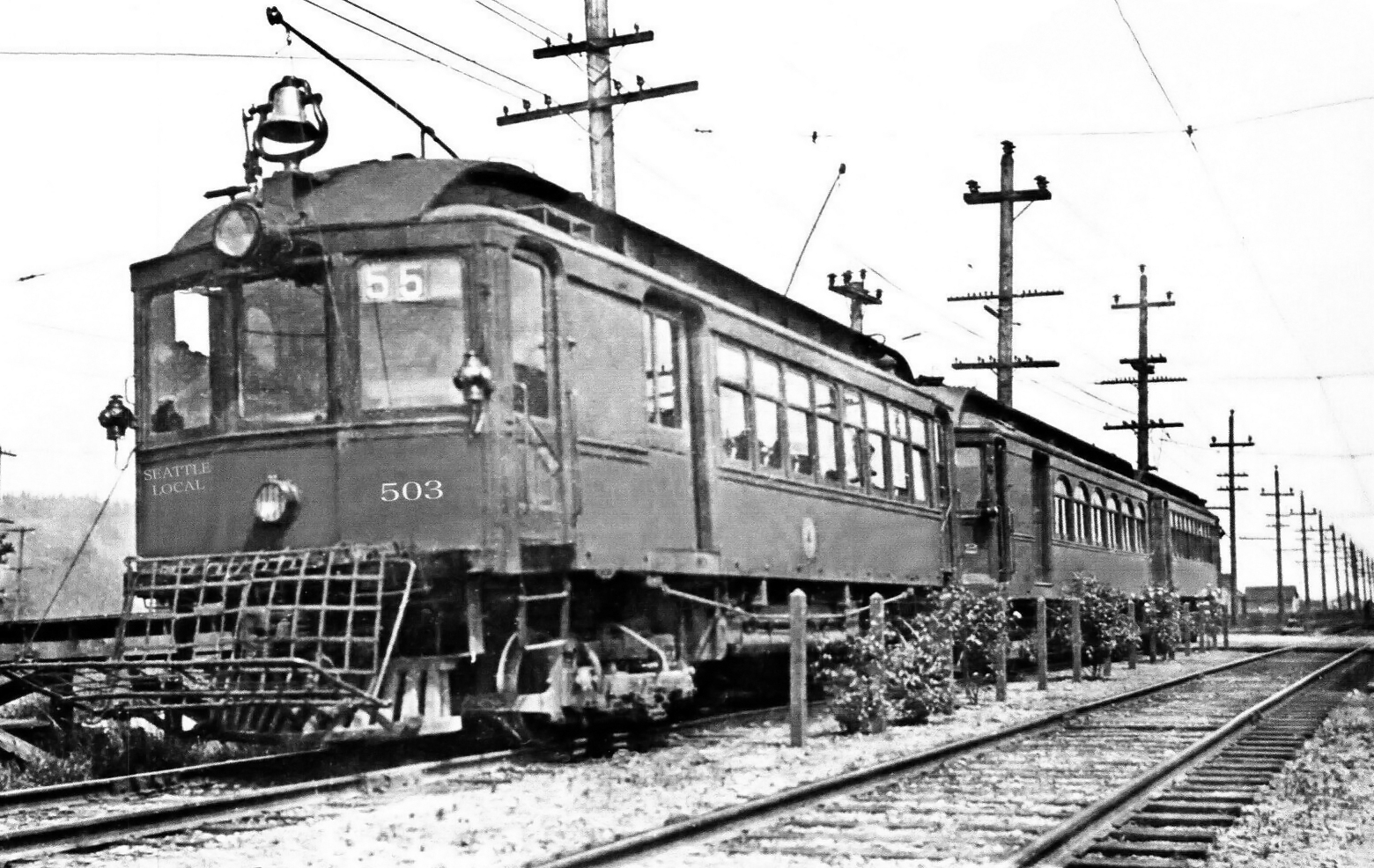Washington State Interurbans and Streetcars: History, Lines, Photos
Last revised: September 10, 2024
By: Adam Burns
Washington contained a significant number of interurbans in the Seattle/Tacoma/Everett region. Of the 381 miles within the state, most were located within the Puget Sound area. It ranked fifth among western states behind Texas, California, Iowa, Oregon. Virtually all of these electrified systems were gone prior to World War II.
Seattle Electric Company
The Seattle Electric Company took over the operations of several smaller interurban railroads in 1900 that served the port city.
In 1919 the operation was renamed the Seattle Municipal Railway and again changed hands in 1939 as the Seattle Transit System. Streetcars survived another two years until 1941.
Everett Railway & Electric Company
The Everett Railway & Electric Company began operations in 1893 serving its namesake city.
It was renamed three times during operations including as the Everett Railway Light & Water Company in 1905, Puget Sound International Railway & Power Company in 1907 and finally the Puget Sound Power & Light Company in 1930. Streetcar operations were discontinued in the mid-1930s.
Tacoma Railway & Power Company
The Tacoma Railway & Power Company began operations in 1899 taking over for a number of smaller companies serving Tacoma. Its name was unchanged during its operations until services were suspended in 1935.
West Side Railway
The West Side Railway began operations in 1891 serving Olympia. It was renamed the Olympia Light & Power Company in 1894 and again in 1923 as the Puget Sound Power & Light Company. Streetcar operations were discontinued in 1930.
Skagit River Railway
The Skagit River Railway was never really a true interurban but did carry out electrified railroad operations. It began life in 1920 as a temporary system managed by Seattle City Light in the construction of hydro-electric dams on the Skagit River. The railroad outlived its temporary status operating until 1954 before being abandoned.
Puget Sound Electric Railway
The Puget Sound Electric Railway began operations in September of 1902 connecting areas of Tacoma and Seattle serving such communities as Milton, Tukwila, Fife, Pacific, Jovita, Algona, Auburn, Kent, Orillia, and Renton. The interurban operated until 1928 when streetcar service was abandoned in favor of buses.
Spokane, Coeur D'Alene & Palouse Railway
The Spokane, Coeur D'Alene & Palouse Railway connected Spokane and Coeur D'Alene on a 32-mile system beginning operations in late December of 1903.
It operated on a 600-volt DC system and in 1907 built a branch to Liberty Lake. A few years later it extended its reach to Vera. The railroad survived until 1939 when passenger operations were abandoned.
Freight service survived until 1960 although in 1943 the system had become part of the Great Northern Railway.
Washington Water Power Company
The Washington Water Power Company began operations in 1905 connecting Spokane with Medical Lake on a system that stretched 17 miles. Operations were abandoned in 1921.
Yakima Valley Transportation Company
The Yakima Valley Transportation Company began operations in 1907 originally connecting Yakima on a three-mile streetcar system. In 1909 it became part of the Union Pacific and was initially expanded between Ahtanum and Wiley City by 1910.
Later in 1912 services were further expanded and reached Selah. Passenger service was entirely abandoned in 1947 although freight service survived until 1985 by Union Pacific.
Also, of note, a tourist trolley operation began in 1974 thus reviving passenger service which remains to this day (which was eventually donated by UP to the City of Yakima in 1985).
Walla Walla Valley Railway
The Walla Walla Valley Railway (initially known as the Walla Walla Traction Company) connected Walla Walla with Milton-Freewater, Oregon on a 14-mile railroad that began operations in April of 1907.
Northern Pacific Railway purchased the property in 1921 and ten years later passenger operations were discontinued. Electric service ended in 1950 and by the 1980s then-owner Burlington Northern abandoned what remaining freight services.
Pacific Northwest Traction Company
The Pacific Northwest Traction Company began operations in 1909 and would eventually connect Seattle, Everett, Mt. Vernon, Snohomish, and Bellingham on a system that reached 62 total miles (the state's largest single interurban railroad). While the PNT had healthy freight earnings to supplement passenger revenue it lasted no longer until the mid-1920s.
Tacoma & Steilacoom Railway
The Tacoma & Steilacoom Railway began operations in 1891 connecting its namesake cities. Soon after it was purchased by the Tacoma Railway & Motor Company and operations lasted only until 1916 before being abandoned.
Seattle, Renton & Southern Railway
The Seattle, Renton & Southern Railway began operations in the 1890s connecting Seattle and Renton. It was reorganized in 1916 as the Seattle & Rainer Valley Railway and operations continued for another 21 years before being abandoned in 1937.
Fidalgo City & Anacortes Railway
The Fidalgo City & Anacortes Railway began operations in March of 1891 connecting its namesake cities on an 11-mile interurban railroad. A horribly planned system it operated only a few years before being abandoned in 1893.
Vancouver Traction Company
The Vancouver Traction Company began operations in 1910 connecting Vancouver with Orchards and Sifton on a 7-mile railroad that was abandoned in 1925.
Twin City Railroad
The Twin City Railroad was owned by Puget Sound Power & Light Company and connected Chehalis and Centralia beginning operations in 1910. Passenger operations were abandoned in 1929 and freight followed seven years later in 1936.
Grays Harbor Railway & Light Company
The Grays Harbor Railway & Light Company began operations in 1904 connecting Hoquiam, Cosmopolis and Aberdeen on a 9-mile railroad. Passenger operations were abandoned in 1932 with freight services lasting until 1941.
Willapa Electric Company
The Willapa Electric Company, originally known as the Willapa Harbor Railway, operated a six-mile which connected South Bend, Raymond and Grays Harbor. All operations were abandoned in 1930.
Contents
Everett Railway & Electric Company
Tacoma Railway & Power Company
Spokane, Coeur D'Alene & Palouse Railway
Washington Water Power Company
Yakima Valley Transportation Company
Pacific Northwest Traction Company
Seattle, Renton & Southern Railway
Fidalgo City & Anacortes Railway
Recent Articles
-
California Halloween Train Rides
Aug 22, 25 10:41 AM
California is home to numerous heritage railroads and excursion trains, many of which host Halloween-themed rides. Learn more about these events here. -
Washington Halloween Train Rides
Aug 22, 25 10:14 AM
The state of Washington is home to a few Halloween or fall-themed scenic trains, including the Mount Rainier Scenic Railroad, Chelatchie Prairie Railroad, and Chehalis-Centralia Railroad & Museum. -
Alabama Halloween Train Rides
Aug 21, 25 11:48 PM
Halloween-themed train rides are offered in Alabama at the North Alabama Railroad Museum and Heart of Dixie Railroad Museum. Learn more here.




